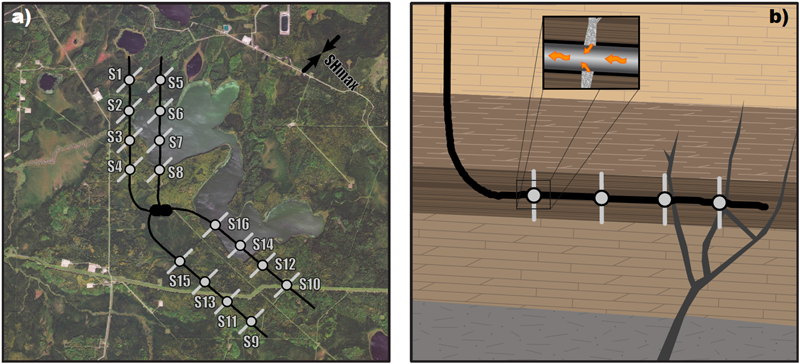Induced seismicity is the process by which human activities trigger an earthquake. Hydraulic fracturing is a technique used by the petroleum industry to create small fractures in rocks with pressurized fluids, allowing for hydrocarbon production. Earthquakes caused by hydraulic fracturing are important to understand because of their impact as a geohazard, especially in areas that were previously seismically quiet. A recent article in Reviews of Geophysics presents the current state of knowledge on hydraulic fracturing induced seismicity. Here, one of the authors gives an overview of earthquakes induced by hydraulic fracturing, and how they are measured and managed.
How does hydraulic fracturing cause earthquakes?
It has been well known for decades that any injection of fluids in the subsurface has the potential to induce earthquakes. That said, hydraulic fracturing has only been recognized as a source of induced earthquakes very recently.
In the simplest conceptual model, fluids injected in a subsurface well must be connected to a fault via some permeable pathway. This allows the fluid pressure inside of the fault to increase during stimulation, hydraulically opening the fault. While hydraulically opened, the reduced ‘clamping’ force on a fault makes it more likely to slip.

How widespread, frequent, and large are hydraulic fracturing induced earthquakes?
Typically less than 1 per cent of hydraulically fractured wells cause induced earthquakes.
Typically less than 1 per cent of hydraulically fractured wells cause induced earthquakes. This rarity appears to be related to the unlikely scenario of having all the correct geological conditions together in same place: tectonic, geomechanical, and hydrological. In other words, pressurized ‘frack’ fluids may cause earthquakes only if a stage happens to be connected to a susceptible fault.
Hydraulic fracturing induced earthquakes occur most frequently during the hydraulic stimulation processes. The process of stimulating all the stages in a single well/pad can take days or weeks, with only some (or none) of the stages causing earthquakes. If earthquakes do occur, the large majority happen within this timeframe. That said, earthquakes can linger after hydraulic fracturing has been completed – for periods of up to weeks or months. In some cases, the largest earthquakes have occurred after the well has been completed.
The largest earthquake caused by hydraulic fracturing was magnitude 5.7
Observationally, the largest earthquake caused by hydraulic fracturing was magnitude 5.7 and occurred in the Sichuan Basin of China on 16 December 2018. Some plays in North America have hosted events larger than magnitude 4.0 as well (for example, Duvernay, Montney, and Eagle Ford).

What are the main physical characteristics of hydraulic fracturing induced earthquakes?
The physical characteristics of these earthquakes appear to be no different than their natural counterparts. Hydraulic fracturing induced earthquakes exhibit the same characteristics that are often associated with natural earthquakes related to fluid-flow: swarm-like sequences, temporal correlation with the injection source, spatial proximity to the fluid source, and a linear relationship between injected volume and number of induced earthquakes. Because of that similarity, this type of induced earthquake provides an opportunity to better understand natural earthquakes related to fluid-flow.
How can scientists work effectively with industry to shape regulation and mitigation efforts?
The key to effective regulation and mitigation is transparency. In this regard, scientists can work towards building trusting relationships with industry, and specifically ones that facilitate the sharing of data openly.
The key to effective regulation and mitigation is transparency. In this regard, scientists can work towards building trusting relationships with industry, and specifically ones that facilitate the sharing of data openly.
Certainly, the widespread dissemination of seismological data has been an important part of creating more comprehensive catalogues of earthquakes, by using various newly developing techniques. Examination of catalogues in numerous jurisdictions has begun to show some supporting evidence for when and where these types of earthquakes may occur.
This open sharing should also include geophysical, geological, and completion engineering data. Many of the unresolved (and unrecognized) problems with induced seismicity are multidisciplinary and would benefit from multiple perspectives.
What are some of the unresolved questions where additional research, data or modelling is needed?
Some of the important and currently unresolved questions are related to effective management – what sorts of conditions allow these earthquakes to occur and what sorts of operational changes can reduce their hazards? Greater knowledge on how to identify susceptible areas before fracking begins, combined with confidence in management tools when earthquakes occur can build significant trust with the general public. In one example, recent research efforts have been focused on better understanding the exact triggering mechanism responsible for reactivating susceptible faults; while the physical process that governs how faults begin to slip is still debated, fluid-flow along portions these faults appears to be an important factor.
—Ryan Schultz ([email protected]; ![]() 0000-0002-1796-9622), Stanford University, USA
0000-0002-1796-9622), Stanford University, USA
Citation:
Schultz, R. (2020), Understanding earthquakes caused by hydraulic fracturing, Eos, 101, https://doi.org/10.1029/2020EO147870. Published on 07 August 2020.
Text © 2020. The authors. CC BY-NC-ND 3.0
Except where otherwise noted, images are subject to copyright. Any reuse without express permission from the copyright owner is prohibited.

